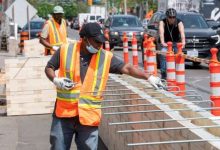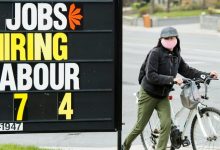Modelling suggests as many as 800,000 COVID-19 infections could sweep Alberta, Premier Jason Kenney says
In a televised address to the province Tuesday evening, Premier Jason Kenney laid out two starkly different scenarios that paint grim pictures of what the next weeks and months may look like in Alberta.
Calling the COVID-19 pandemic “perhaps the greatest challenge of our generation,” Kenney said his government must act to deal with three crises at once, and must focus first on saving lives, then on rebuilding an economy in ruins.
On the health care front, Kenney outlined what he called a “probable” scenario, based on modelling projections, that suggests Alberta will hit the peak of coronavirus infections in mid-May.
Under that scenario, by the end of summer, the province could see as many as 800,000 infections, and between 400 and 3,100 deaths.
He also spoke directly to Albertans, many of whom are self-isolating at home, about a more serious but less likely “elevated scenario,” which would see infections peak at the beginning of May with as many as 1 million, and between 500 and 6,600 deaths.
See the numbers ‘as a challenge’
“I know that these numbers can be overwhelming,” Kenney said. “But these models are not a done deal. I want Albertans to see them as a challenge.”
As of Tuesday, 1,373 people in the province have tested positive for COVID-19, with 42 of them in hospital. Twenty-six people have died from the illness.
Kenney said epidemiological models suggest Alberta won’t be able to start relaxing physical distancing measures until the end of May.
On the economic front, Kenney said, the government has already committed $12 billion to more than two dozen initiatives, such as deferrals on taxes, mortgages, utility payments, and student loans, and given extra money for homeless shelters and charities serving the isolated.
The third crisis crippling the province, Kenney said, was the collapse in global energy prices, made worse recently by a feud between the governments of Saudi Arabia and Russia.
The extra spending already committed, combined with a collapse in provincial revenues, could see Alberta’s budget deficit this year triple from $7 billion to almost $20 billion, he said.
“We will face a great fiscal reckoning in the future. I know that many Albertans are fearful of what lies ahead.”
Much depends on Albertans themselves
Kenney then referenced a quotation from former U.S. president Franklin Roosevelt, who told Americans in the early years of the Great Depression that they had “nothing to fear but fear itself.”
The outcome of the health-care crisis, the premier said, will in part depend on what the people of Alberta do themselves in the coming days and weeks, on whether they continue to follow public health orders that have closed schools and most businesses and limited public gatherings.
“How this actually plays out,” Kenney said, “how many people are infected, how many die, whether we overwhelm our health-care system – all of that depends on us and our choices.”
The countermeasures being led by Dr. Deena Hinshaw, the chief medical officer of health, are already working, the premier said.
“Our experts project that if we had no social distancing and public health orders in place, we could experience as many as 1.6 million infections, and 32,000 deaths in Alberta – as many as 640 deaths per day. Our health system would collapse under the chaos of that scenario.”
Save lives and rebuild economy
In an address that referenced the Spanish Flu pandemic, the First World War, and the Great Depression of the 1930s, Kenney said the government’s first priority will be protecting people’s health and saving lives.
But the damage to the economy is also having an impact on the health and well-being of Albertans, he said, which means the province cannot solely focus on either the pandemic or the economy.
“The two are intertwined,” he said.
“We must do everything within our power to defeat the invisible enemy of the novel coronavirus. The more we do to stop the pandemic now, the faster we can restart our economy, and pave a path to recovery.”
Alberta’s per capita number of recorded infections is the second highest in Canada, after Quebec, Kenney said.
In part, that’s because the province has conducted one the highest levels of testing in the world, he said, which has helped public health officials track close contacts of those who are infected, which limits the spread.
Reinforcing Kenney’s comments, Opposition Leader Rachel Notley said the projected numbers were not inevitable.
“Our ability to keep these numbers low is within our power and forms a shared responsibility for all Albertans,” Notley said. “This isn’t just for our own safety. It’s for those who are around us, for all of us. That means we must follow the advice from public health officials. We must take this seriously and continue physical distancing.”
But she said relieving financial stress for Albertans also required reopening the emergency support payments that closed Monday.
Despite the relatively high number of cases, the premier said, the rates of Albertans hospitalized with COVID-19 – and those in ICU beds – are much lower than in Ontario, Quebec and B.C.
“The key strategy in our plan to defeat the coronavirus is this: to push down that peak of infections as much as we can, while pulling up the capacity of our health care system to cope,” Kenney said.
“Thanks to the efforts of everyday Albertans to follow our public health rules, we are pushing that curve down.”
Once past the peak, when physical distancing rules begin to relax, Kenney said, the government plans to use new methods now being developed to conduct mass testing, with the goal of doing up to 20,000 tests a day.
CBC








Redes Sociais - Comentários